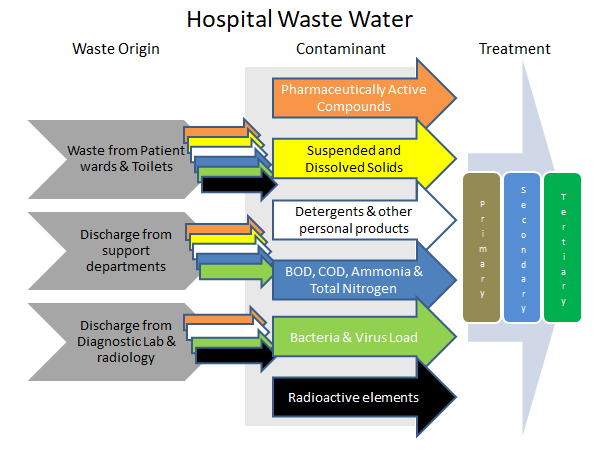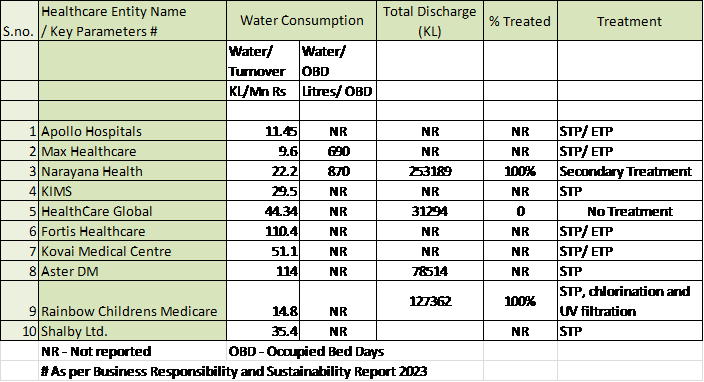
Clean water & Sanitation is one of the 17 UN Sustainable Development Goals (SDG). From Sustainable healthcare point of view, Hospital waste water (HWW) treatment before releasing it into the environment is a crucial element. Water waste management is a major concern for hospitals. The effluent coming out of hospitals are heavily polluted with several types of difficult to remove contaminants such as Pharmaceutically Active Compounds (PhACs), many kinds of microorganisms including bacteria and virus, ammonia, nitrate, nitrogen, suspended solids, detergents, strong chemicals, reagents, heavy metals and radio-active elements etc. The hospital waste water is characterized by high biochemical oxygen demand (BOD) and chemical oxygen demand (COD), making it more difficult to treat than domestic waste water. Releasing this waste water without adequate treatment is terribly damaging to the environment and ecosystem.
Why is Hospital Water Waste a concern?
Most hospitals in India, release large amounts of untreated waste water polluting soil surface directly or into the municipality sewage system. Only large hospitals have water treatment plants within their facility (STP/ ETP). Hospital Waste Water is a serious concern because its biodegradability index is much lower than the municipal wastewater, which normally carries domestic water waste. The municipal water treatment facilities are largely equipped to treat domestic water waste only. Most of the sewage treatment plants are not designed to handle bio-medical waste and persistent organic compounds.
The low biodegradability of HWW makes it difficult to treat by conventional biological systems that municipal treatment plants employ. Mixing up untreated HWW into municipal water waste means that overall the water may not be adequately treated for all the pollutants it carries. Imagine that this inadequately treated water is released into the soil, sewer, lakes & ponds and eventually may find its way to our potable water sources, harming everyone.
Water usage and waste in hospitals is not small
The amount of water consumed and wastewater generated from the hospital depends on its capacity, type and size of the facilities and services provided (laundry, kitchen, air-conditioning), in-house wastewater management facilities available, etc.
As per recent BRSR reports for FY2023, filed by top listed hospitals average water consumption was about 700-900 Litres/occupied bed/day. As per these reports only roughly 65-70% water intake is consumed and nearly 30-35% is discharged as waste.
Contaminants present in Hospital Waste Water
The Hospital Waste Water carries a much higher and more complex contaminant load of various kinds as compared to domestic waste water. The following types of contaminants could be present in the hospital waste water:
Effluent from patient wards
The effluent coming out of the toilets in hospital wards mainly contains fecal matter and urine just like domestic sewage. However, unlike domestic toilets discharge, the toilet waste from hospitals is pathogenic and has many other contaminants as described further.
High bacterial and viral load
As the sewage is mainly from patients, the microorganisms are pathogenic with high bacterial and viral load. Microorganisms include antibiotic-resistant bacteria (ARB), antibiotic-resistant genes (ARG), persistent viruses etc. that often continue to exist even after the waste water treatment (primary and secondary) in the hospital, if any.
High Physicochemical parameters
HWW has higher biochemical oxygen demand (BOD), chemical oxygen demand (COD), ammonia, and nitrogen as compared to the domestic wastewater.
BOD is the amount of oxygen consumed by microorganisms to decompose organic matter under aerobic conditions, specific temperature and duration of time. COD is the amount of oxygen equivalents consumed in the chemical oxidation of organic matter by a strong oxidant. Hence BOD can be referred to as the biodegradable fraction of wastewater, while COD is the measure of both biodegradable and non-biodegradable organic compounds. The ratio of BOD and COD of wastewater is referred to as the biodegradability index.
The biodegradability index of HWW is lower compared to domestic waste water, which means that additional advanced methods are required to treat it, which typical Sewage treatment plants (STP) are not designed for.
High Pharmaceutically active compounds
The effluents also contain un-metabolized Pharmaceutically Active Compounds (PhACs), from the medications administered to the patients during treatment. PhACs such as analgesics, antibiotics, β-blockers, hormones, etc. were commonly found in significantly higher concentration as per certain studies. These recalcitrant organic compounds are highly toxic with very low drinking water equivalent limit values, making them a serious threat to the environment and obviously harmful to humans, flora, fauna and biodiversity at large.
TSS / TDS in hospital waste water
Hospital waste water is found to be high on total suspended solid (TSS) and total dissolved solids (TDS). TSS refers to waterborne particles that exceed 2 microns in size. While particles smaller than 2 microns, is considered a total dissolved solid (TDS). The total suspended solids comprise mainly of inorganic materials such as sand, sediments and organic particles from plant and animal or microorganisms such as plankton, algae and bacteria.
Effluent discharge from Laundry, CSSD & Other Cleaning areas
Waste water from hospital laundry, central sterile supply department (CSSD), operating theatres, kitchen and other ancillary areas contain suspended solids, detergents & other strong chemicals much in excess. They also contain pathogens from sterilising instruments, linen etc.
Water discharge from diagnostic areas
The wastewater generated from laboratory, radiology departments etc., contains substances, such as disinfectants, detergents, acids, alkalis, pharmaceutical residues, solvents, radioactive X-ray contrast media, etc. These substances are highly toxic, persistent and hard to remove through conventional treatment processes.
What are the waste water treatment stages and methods prevalent today?
There are three levels of waste water treatment – primary, secondary and tertiary. Primary treatment is required to provide a pre-treatment to the hospital wastewater. The resulting effluent can be treated using different biological processes, such as ASP, MBR, MBBR, and CWs (Secondary Treatment). These biological units can also be combined with different disinfection, adsorption or advanced oxidation technologies to enhance the removal of recalcitrant organic pollutants. Tertiary treatment can also be provided directly after primary treatment; however, it is less effective due to high organic and nutrient load.
Primary waste water treatment
The most common initial treatment component is the septic tank which provides primary treatment. A preliminary treatment can be prior to this stage to filter out large contaminants. Primary treatment occurs through processes like filtration and sedimentation, that result in removal of floating (scum) and materials (sludge) present in wastewater that will settle and separate out (elements such as oil, sand and debris) from water.
Secondary waste water treatment
Secondary wastewater treatment is a biological treatment process (i.e. it uses bacteria to break down dissolved organic material) designed to reduce the amount of organic materials in the wastewater before it is discharged for disposal in the soil or waterbody. The treatment involves removal of biodegradable organic matter (BOD) and suspended solids (TSS) through the processes of aeration and filtration. Various treatment technologies such as activated sludge process (ASP), membrane bioreactor (MBR), moving bed bioreactor (MBBR), constructed wetlands (CWs) etc. have been used as biological treatment methods. Secondary treatment may also include disinfection to remove harmful microorganisms using chlorine or ultraviolet light.
As per various studies, secondary treatment involving biological treatments methods such as ASP, MBR, CW etc. mentioned above, have proven to be effective in removal of most biodegradable matters. However, several PhACs, certain antibiotic resistant bacteria and viruses, radioactive substances etc. were persistent and not adequately removed with the help of secondary treatment. More advanced tertiary treatment was required in addition to obtain satisfactory results.
Tertiary waste water treatment
Tertiary waste water treatment involves the reduction of nutrients (such as nitrogen, phosphorus, PhACs etc.) through more advanced treatment processes. The treatment methods include techniques such as carbon adsorption, advanced membranes filtration (micro, ultra or nano filtration), ion exchange process, chlorination/ dechlorination, ozone treatment, reverse osmosis, activated carbon filters, ultraviolet disinfection systems etc. Emerging technologies for removing recalcitrant elements include – photocatalytic treatment, Fenton oxidation, anodic oxidation, nano filtration etc.
Top 10 Indian hospital groups – water consumption and treatment data
Let us look at what some of the top listed hospital groups in India are doing, as regards water consumption and waste water treatment. The following details can be observed from analysis of the Business Responsibility & Sustainability Reports filed for FY2023.

Water consumption figures as ratio of turnover varied widely between about 10-114 KL/ Rs in Mn. Most certainly many hospitals have significant opportunities for water consumption efficiencies. Most entities have reported using Sewage Treatment and/or Effluent Treatment Plants for water treatment. However, only two have reported 100% treatment of waste water discharged. Since others have not provided the break-up of treated water, it is not clear what portion of waste water is treated and if all units in the group have treatment facilities or not. It also appears that most of the treatment is secondary level treatment. It is not clear if advanced treatment as may be required to remove recalcitrant pollutants, is employed.
Conclusion
It is clear from the above discussions that treatment of Hospital Waste Water using domestic wastewater treatment plants may not be adequate as it does not remove many hospital generated toxic contaminants. Secondary Waste Water Treatment is effective in removal of most biodegradable material from waste water, but several pharmaceutically active compounds, antibiotic resistant bacteria/ virus, radioactive elements etc. still persist in toxic proportions. Large hospitals in India have STP/ ETP facilities. However more that 90% of the hospitals are small and medium hospitals / Nursing Homes set-up in residential areas, with no waste water treatment facilities at all. All of these hospitals drain the untreated water into municipal sewage or soil directly causing considerable damage to environment and immediate ecosystem.
Is this not causing more harm than good? Clearly Indian hospitals have a long way to go as far as waste water treatment is concerned.
PrimedeQ is an e-Marketplace for buying, selling, renting, servicing and spares of medical equipment. We offer all types of used / refurbished medical equipment. We also offer repair services for all types of medical equipment.
Contact us for any medical equipment requirements on 7019759765 or [email protected]
https://in.linkedin.com/in/shanthi-mathur-ab07838
